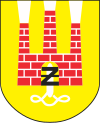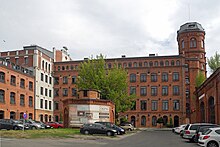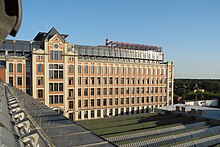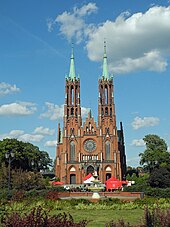Żyrardów
| Żyrardów | ||
|---|---|---|

|
|
|
| Basic data | ||
| State : | Poland | |
| Voivodeship : | Mazovia | |
| Powiat : | Żyrardów | |
| Area : | 14.35 km² | |
| Geographic location : | 52 ° 3 ' N , 20 ° 26' E | |
| Residents : | 39,896 (Jun. 30, 2019) |
|
| Postal code : | 96-300 | |
| Telephone code : | (+48) 46 | |
| License plate : | WZY | |
| Economy and Transport | ||
| Street : | Sochaczew - Piotrków Trybunalski | |
| Rail route : | Łódź – Warsaw | |
| Next international airport : | Warsaw | |
| Gmina | ||
| Gminatype: | Borough | |
| Residents: | 39,896 (Jun. 30, 2019) |
|
| Community number ( GUS ): | 1438011 | |
| Administration (as of 2012) | ||
| Mayor : | Andrzej Wilk | |
| Address: | pl. Jana Pawła II 1 96-300 Żyrardów |
|
| Website : | www.zyrardow.pl | |
Żyrardów [ ʒɨ'rarduf ] is a Polish district town with 41,000 inhabitants in the Masovian Voivodeship . It is located 45 km southwest of the Polish capital Warsaw .
history
The story is closely linked to the development of linen production in the company complex located here.
Karol Scholtz & Comp.
The history of today's town of Żyrardów began in 1829/30 when the entrepreneur Karol Scholtz founded the company "Karol Scholtz & Comp." And decided to set up a linen weaving mill in what was then the village of Ruda Guzowska, which belonged to the Counts of Łubieński . This company was founded in 1828 by Philippe de Girard in Marymont (today a district of Warsaw). Jan Jakub Gay had built the so-called “old spinning mill” from 1829 to 1833, so that in 1833 the linen weaving mill “Karol Scholtz & Comp.” Was able to start its work as the first linen factory in the Russian Empire . The name of the later town Żyrardów was derived from the name of the French engineer and first technical manager of the factory Philippe de Girard. He was able to put his invention of a flax spinning machine into practice here. Despite the good reputation of its high-quality products, the plant in Żyrardów had no economic success due to high production costs and the associated debt, so in 1847 it was taken over by the Polish Bank ( Bank Polski ) in Warsaw . From 1845 Żyrardów had a rail connection through the newly built Warsaw-Vienna railway line .
Hielle & Dittrich
In 1857 the company " Hielle & Dittrich ", which had been founded in 1849 by the two entrepreneurs Carl August Dittrich (1819–1886) and Karl Theodor Hielle (1822–1871) in Schönlinde in Northern Bohemia, took over the textile companies from the Polish Bank ( Flax spinning, weaving and bleaching) in Żyrardów near Warsaw in what was then Russian Poland . Initially the company operated 3,000 spindles and had around 500 employees. As a result, the company traded as "Zyrardower Manufacturen Hielle & Dittrich". The spinning mills and weaving mills were further expanded and a factory settlement was created for the workers of the plant, so that by 1883 the company had 1900 employees and a turnover of 1 million rubles. The company's empire also included the cotton factory in Zduńska Wola near Sieradz in what was then Russian Poland. The textile factories then shaped the face of the city of Żyrardów and the company developed into one of the largest and most modern linen factories in Europe at that time. A complete residential area with brick buildings that are now listed as historic monuments was built for the employees. In the factory settlement there were houses for workers and managers as well as churches, schools, kindergartens, a hospital and various service providers. The city was built on the idea of a "city in the country" with a regular road network, gardens and lots of trees. This settlement still exists today and forms the center of the city. The city was shaped by its multiethnic inhabitants. Besides the Poles, Austrians and Germans, Czechs and Slovaks, Scots and English as well as Russians and Cossacks of different denominations lived and worked here . There were two Roman Catholic churches, a Lutheran church, a Russian Orthodox church, a Baptist church, and a synagogue for the Jews. In 1889 Żyrardów was visited by the Persian Shah Naser ad-Din Shah . Propaganda by radical left parties led to the first mass strike in Poland in the company in April 1883. After the death of Carl August Dittrich the company was taken over by his son Carl Dittrich jr. (1853–1918) continued and converted into a stock corporation in 1885.
Around 1900 there were around ten thousand employees. The turnover amounted to over 6 million rubles a year. This made the factory in Żyrardów one of the largest industrial plants in Poland. In 1900 the city of Żyrardów was presented as a model settlement at the World Exhibition in Paris. The company "Hielle & Dittrich" had around 40 branches and shops in what was then Russia, including Russian Poland, for the sale of their linen products, including in Warsaw (in the Kraków suburb ), in Kalisz , in Czestochowa , in Poznan and in St. Petersburg . Their products have been presented at many exhibitions, for example in Paris , Munich , Berlin , Vienna , Budapest and Moscow , where they also won first prizes. In 1913 the so-called "New Spinning Mill" was built. The Resursa theater from 1875 and the Volkshaus (culture house) built in 1913 are still in use today. In 1916 Żyrardów received city rights.
The son of the founder Carl Dittrich jr. (* 1853 in Schönlinde; † 1918 in Weißer Hirsch / Dresden ) was, from 1879 to 1918 partner and until 1899 director of the company Hielle & Dittrich in Żyrardów, one of the most outstanding personalities in the history of the city. While his father was still alive, he took over the management of the Zyrardow factories in the 1880s. As director of Hielle & Dittrich, he supported important investments in the Żyrardow community, e. B. the building of churches, the building of a Catholic and Protestant cemetery, the building of a school and a hospital. He also promoted cultural activities (Resursa theater, concert hall, culture house). He took over the patronage for cultural projects and financed scholarships for talented young people from Schönlinde and Żyrardów. In the years 1903–1908 he financed the studies of the writer and translator Paweł Hulka-Laskowski (1881–1946) at the University of Heidelberg . The “court painter” of the Dittrich family was August Frind from Schönlinde, who created the portraits of Carl August Dittrich and Karl Hielle for the representative villa in Żyrardów and altarpieces for the Catholic Borromeo Church and the Protestant Church of the Assumption in Żyrardów. In the years 1889-1896, a representative villa in the style of the French neo-Renaissance was built for Karl Dittrich in the city park, in which he never lived and which is now used as the West Mazovian Museum Żyrardów. In 1899 he sold his private shares in the joint stock company of Żyrardów-Werke. He used the money from the sale of the shares (about 800,000 rubles) for charitable and social purposes and was intended for the employees of the joint stock company of the Werkeyrardów works, e.g. B. an old-age pension for civil servants as well as for ordinary workers. He also supported the operation of an orphanage, the construction and maintenance of a retirement home and the construction of a Roman Catholic and Protestant church as well as the plant fire brigade and a factory orchestra. Together with his three sisters, he founded his father's name foundation, which provided the employees and workers of the linen factories with interest-bearing savings accounts worth 50 rubles if they regularly saved 3 percent of their monthly income.
After the First World War
Large parts of the plant were destroyed in World War I or dismantled by the Russian Army in 1915. In 1920 about 30% of the shares were still owned by Hielle & Dittrich. After the reconstruction in 1923, the company was acquired by the French stock corporation Marcel Boussac. Because of the poor working conditions, a press campaign was initiated against the company management, as a result of which the company was placed under state administration again in 1936. After the Second World War, the plant was rebuilt and was then a major cotton combine in the People's Republic of Poland , which then went bankrupt in the 1990s.
Restoration and use in the present
The main buildings, the Old Spinning Mill (Stara Przędzalnia) and the New Spinning Mill (Nowa Przędzalnia), and some outbuildings have already been renovated. They are used as apartments (lofts - "Lofty de Girarda"), offices, shops and as a hotel, other company buildings are still waiting for investors. The old factory settlement is inhabited but not yet renovated. The restoration of the Palais Dittrich as a West Mazovian Museum is currently underway, located directly at the city park (Karol-Dittrich-Park). The former Resursa building has been renovated and is used as a hotel, restaurant and information center.
The site's list of monuments includes 296 objects. Most of the city's cultural monuments are located in the historical factory settlement (Polish: Osada Fabryczna ) from the 19th century and the beginning of the 20th century. The Żyrardów factory settlement is currently the only completely preserved urban complex of an industrial town from this period in Europe. Most residential and public buildings still have their old functions. In 2012, the factory estate was given the status of a conservation area. This is the highest form of monument protection in Poland. The historical settlement of Żyrardów is one of the 50 most important monuments in Poland.
The first mayor of the city from 1915 was Józef Procner (1864–1952).
Attractions
- Old spinning mill - Stara Przędzalnia in Żyrardów, built in 1833, architect: Jan Jakub Gay (1801–1849), conversion to a residential and service building from 2005 to 2009 by the Anna and Piotr Błażejewski family
- New spinning mill - Nowa Przędzalnia in Żyrardów, built 1912–1913, one of the first reinforced concrete buildings in Poland, converted into a residential and service building from 2007 to 2009
- Parish Church of St. Borromeo (1891)
- Former Protestant Ascension Church (1898)
- Parish Church of Our Lady of Consolation, built in the years 1900–1903 in neo-Gothic style based on a design by Józef Pius Dziekoński ("Father of Polish Neo-Gothic"), the model was the Viennese Votive Church , built with funds from C. Dittrich jr. who also provided over 3 million bricks from his own brick factory in Radziejowice . The church windows were made in Józef Mehoffer's studio . Next to it is the rectory (1903).
- Resursa House (built around 1870, newly restored) with frescoes and polychrome pictures by T. Bagiński with theater hall (formerly ballroom), restaurant, library and billiards room
- Tyrolean house of Ludwig Marcellin, former director from 1867 to 1871
- Villa Wilhelm Haupt, managing director of the company
- Palais Dittrich (1889-1896) in the style of the French neo-Renaissance, located in the city park (Karl-Dittrich-Park), now the West Mazovian Museum with the authentic panorama of the city from the 19th century with the dimensions 367 × 140 cm and a collection of paintings by the painter Józef Rapacki (1871–1929). The city park was laid out in the years 1886-1896 based on a design by the Saxon garden architect Karl Sparmann.
- Kindergarten (building with a characteristic dome)
- "Ludowiec" cultural center (People's House) (1913)
In memory of the two entrepreneurs Dittrich and Hielle in Żyrardów, two streets were named after them.
sons and daughters of the town
- Alfred Ernest Garvie (1861–1945), British Reformed theologian
- Paweł Hulka-Laskowski (1881–1946), writer
- Albert Breyer (1889–1939), German-Polish ethnographer, elementary school teacher and publicist
- Walter Brand (1907–1980), Sudeten German politician
- Leszek Miller (* 1946), politician, Prime Minister of Poland from 2001 to 2004
- Lechosław Michalak (* 1956), racing cyclist
- Piotr Gontarczyk (* 1970), historian and political scientist
- Dariusz Kaczanowski (* 1971), politician
- Paweł Sajak (* 1977), member of the Sejm
- Rafał Ratajczyk (* 1983), track and road cyclist
- Piotr Nowakowski (* 1987), volleyball player
Twin cities
- Lourmarin (France) (since 2004)
- Hajdúszoboszló (Hungary)
- Delčevo (Macedonia)
- Le Creusot (France)
- Siero (Spain)
- Tangshan (China)
- Krásná Lípa (Czech Republic) (since 2016)
- Tryavna (Bulgaria) (since 2017)
literature
- Krzysztof Zwoliński: Zakłady żyrardowskie w latach 1885–1915 (The Żyrardów works in the years 1885–1915). Książka i Wiedza, Warsaw 1979 (Polish).
- A. Stawarz, M. Procner (Eds.): Pamiętniki Józefa Procnera (Memoirs of Josef Procner) (Polish). Żyrardów 2009, ISBN 978-8-392-89884-9 .
Web links
- City website (Polish)
Individual evidence
- ↑ a b population. Size and Structure by Territorial Division. As of June 30, 2019. Główny Urząd Statystyczny (GUS) (PDF files; 0.99 MiB), accessed December 24, 2019 .
- ↑ Żyrardów - Local History (accessed October 6, 2019)
- ↑ Founder was the entrepreneur Karol Scholtz, actually Karol Fürchtegott de Scholtz (* 1784 in Cieślin, Gmina Klucze in the Lesser Poland Voivodeship ), see Cieślin - Karol Scholtz (Polish) (accessed October 17, 2019)
- ↑ Jacek Grzonkowski: Pantheon of Personalities from Żyrardów (Polish) (accessed October 6, 2019)
- ↑ Mateusz Waśkowski, from Echo Żyrardowskie No. 89 (Polish) (accessed October 6, 2019)
- ↑ West Mazovian Museum in Żyrardów (Polish) (accessed October 17, 2019)
- ↑ Barbora Větrovská, Stanislav Děd: Text on the exhibition on the occasion of the seminar “Odkaz rodiny Dittrich z Krásné Lípy” (The legacy of the Dittrich family from Schönlinde on the occasion of the 200th birthday of Carl August Dittrich) on October 4, 2019 in Krásná Lípa, organized by Omnium zs Prague
- ↑ Mateusz Waśkowski, from Echo Żyrardowskie No. 92 (Polish) (accessed October 6, 2019)
- ↑ Żyrardów. XIX-wieczna Zabytkowa Osada Fabryczna (Historical Factory Estate from the 19th Century) (Polish) (accessed October 17, 2019)
- ↑ Żyrardów - XIX-wieczna osada fabryczna (Historical factory settlement from the 19th century) (Polish) (accessed October 17, 2019)
- ↑ Graphic Procner (accessed April 20, 2020)
- ↑ Historia Stara Przędzalnia (Polish) (accessed October 17, 2019)
- ↑ Historia Resursa (Polish) (accessed October 17, 2019)
- ^ Tiroler Haus 1869 (Polish) (accessed October 6, 2019)
- ↑ Tour of the 19th century factory settlement (Polish) (accessed October 17, 2019)












